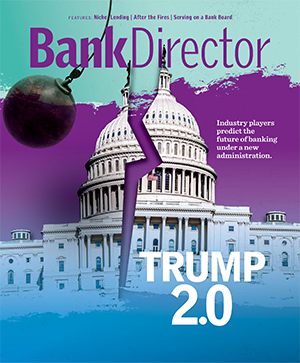
How Innovative Banks Keep Up With Compliance Changes
 Bankers and directors are increasingly worried about compliance risk.
Bankers and directors are increasingly worried about compliance risk.
More than half of executives and directors at banks with more than $10 billion in assets said their concerns about compliance risk increased in 2018, according to Bank Director’s 2019 Risk Survey. At banks of all sizes, 39 percent of respondents expressed increasing concern about their ability to comply with changing regulations.
They’re right to be worried. In 2018, U.S. banks saw the largest amount of rule changes since 2012, according to Pamela Perdue, chief regulatory officer for Continuity. This may have surprised bankers who assumed that deregulation would translate to less work.
“The reality is that that is not the case,” she says. “[I]t takes just as much operational effort to unwind a regulatory implementation as it does to ramp it up in the first place.”
Many banks still rely on compliance officers manually monitoring websites and using Google alerts to stay abreast of law and policy changes. That “hunt-and-peck” approach to compliance may not be sufficiently broad enough; Perdue said bankers risk missing or misinterpreting regulatory updates.
This potential liability could also mean missed opportunities for new business as rules change. To handle these challenges, some banks use regulatory change management (RCM) technology to aggregate law and policy changes and stay ahead of the curve.
RCM technology offerings are evolving. Current offerings are often included in broader governance risk and compliance solutions, though these tools often use the same manual methods for collecting and processing content that banks use.
Some versions of RCM technology link into data feeds from regulatory bodies and use scripts to crawl the web to capture information. This is less likely to miss a change but creates a mountain of alerts for a bank to sort through. Some providers pair this offering with expert analysis, and make recommendations for whether and how banks should respond.
But some of the most innovative banks are leveraging artificial intelligence (AI) to manage regulatory change. Bank Director’s 2019 Risk Survey revealed that 29 percent of bank respondents are exploring AI, and another 8 percent are already using it to enhance the compliance function. Companies like San Francisco-based Compliance.ai use AI to extract regulatory changes, classify them and summarize their key holdings in minutes.
While AI works exponentially faster than human compliance officers, there are concerns about its accuracy and reliability.
“I think organizations need to be pragmatic about this,” says Compliance.ai chief executive officer and co-founder Kayvan Alikhani. “[T]here has to exist a healthy level of skepticism about solutions that use artificial intelligence and machine learning to replace what a $700 to $800 an hour lawyer was doing before this solution was used.”
Compliance.ai uses an “Expert in The Loop” system to verify that the classifications and summaries the AI produced are accurate. This nuanced version of supervised learning helps train the model, which only confirms a finding if it has higher than 95 percent confidence in the decision.
Bankers may find it challenging to test their regulatory technology systems for accuracy and validity, according to Jo Ann Barefoot, chief executive officer of Washington-based Barefoot Innovation Group and Hummingbird Regtech.
“A lot of a lot of banks are running simultaneously on the new software and the old process, and trying to see whether they get the same results or even better results with the new technology,” she says.
Alikhani encourages banks to do proofs of concept and test new solutions alongside their current methodologies, comparing the results over time.
Trust and reliability don’t seem to be key factors in bankers’ pursuit of AI-based compliance technology. In Bank Director’s 2019 Risk Survey, only 11 percent of banks said their bank leadership teams’ hesitation was a barrier to adoption. Instead, 47 percent cited the inability to identify the right solution and 37 percent cited a lack of viable solutions in the marketplace as the biggest deterrents.
Bankers who are adopting RCM are motivated by expense savings, creating a more robust compliance program and even finding a competitive edge, according to Barefoot.
“If your competitors are using these kinds of tools and you’re not that’s going to hurt you,” she says.
Potential Technology Partners
Continuity
Combines regulatory data feeds with consultative advice about how to implement changes.
Compliance.ai
Pairs an “Expert in the Loop” system to verify the accuracy of AI summaries and categorization
OneSumX Regulatory Change Management from Wolters Kluwer
Includes workflows and tasks that help banks manage the implementation of new rules and changes
BWise
Provides impact ratings that show which parts of the bank will be impacted by a rule and the degree of impact
Predict360 from 360factors
Governance risk and compliance solution that provides banks with access to the Code of Federal Regulations and administrative codes for each state
Learn more about each of the technology providers in this piece by accessing their profiles in Bank Director’s FinXTech Connect platform.



